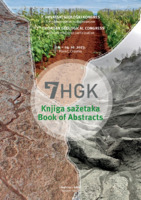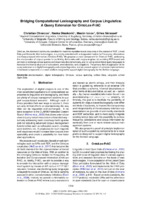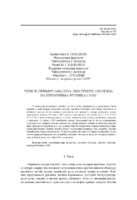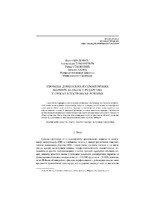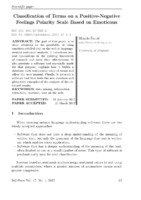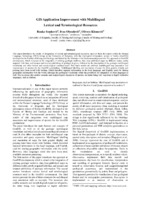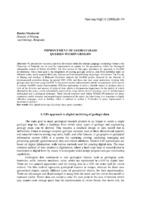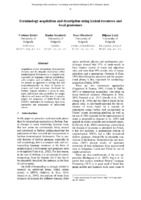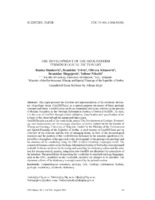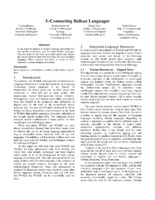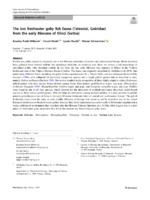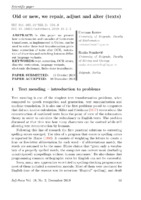Претрага
121 items
-
E-Dictionaries and Finite-State Automata for the Recognition of Named Entities
Krstev Cvetana, Vitas Duško, Obradović Ivan, Utvić Miloš. "E-Dictionaries and Finite-State Automata for the Recognition of Named Entities" in Proceedings of the 9th International Workshop on Finite State Methods and Natural Language Processing, FSMNLP 2011, July 2010, Blois, France, A. Maletti and M. Constant (eds.), :Association for Computational Linguistics (2011): 48-56
-
CEEPUS Network CIII-RS-0038: Recognition of challenges in geological education in South-Eastern Europe and prompt responds
Sibila Borojević Šoštarić, Kristina Šarić. "CEEPUS Network CIII-RS-0038: Recognition of challenges in geological education in South-Eastern Europe and prompt responds" in Knjiga sažetaka 7th Croatian Geological Congress with international participation, Poreč, 2-4 October 2023, Zagreb : Hrvatski geološki institut – Croatian Geological Survey (2023)
-
Using Lexical Resources for Irony and Sarcasm Classification
The paper presents a language dependent model for classification of statements into ironic and non-ironic. The model uses various language resources: morphological dictionaries, sentiment lexicon, lexicon of markers and a WordNet based ontology. This approach uses various features: antonymous pairs obtained using the reasoning rules over the Serbian WordNet ontology (R), antonymous pairs in which one member has positive sentiment polarity (PPR), polarity of positive sentiment words (PSP), ordered sequence of sentiment tags (OSA), Part-of-Speech tags of words (POS) ...... of this set of word forms. For that purpose, we used a hybrid system for Serbian that combines three NLP tasks: PoS tagging, compound and named-entity recognition [10] (step 5 in Fig. 1) that was trained on various annotated texts – literary, newspaper and textbooks. Tagging results are represented by ...
... cases a corpus consisting of tweets was used, andwe have developed a similar resource for Serbian which we present in Section 3. A sys- tem for recognition and tagging of ironic tweets based on the SWN ontology and other language resources is presented in Section 4. The results of the evaluation of the ...
... leading to irony detection precision of 85.4% and 68.3%, respectively. In research described in [29] five linguistic patterns were suggested for recognition of ironic statements in a corpus of tweets in Chinese, while authors in [32] used the pattern “about as * as *” as a query sent to the Google Search ...Miljana Mladenović, Cvetana Krstev, Jelena Mitrović, Ranka Stanković. "Using Lexical Resources for Irony and Sarcasm Classification" in Proceedings of the 8th Balkan Conference in Informatics (BCI '17), New York, NY, USA, : ACM (2017). https://doi.org/
-
Bridging Computational Lexicography and Corpus Linguistics: A Query Extension for OntoLex-FrAC
OntoLex, dominantni standard zajednice za mašinski čitljive leksičke resurse u kontekstu RDF-a, Linked Data i tehnologija Semantičkog veba, trenutno se proširuje sa posebnim modulom za Frekvencije, Primere i Informacije zasnovane na Korpusu (OntoLex-FrAC). Predlažemo novi komponent za OntoLex-FrAC, koji se bavi inkorporacijom korpusnih upita za (a) povezivanje rečnika sa korpusnim mašinama, (b) omogućavanje RDF baziranih web servisa da dinamički razmenjuju korpusne upite i podatke odgovora, i (c) korišćenje konvencionalnih upitačkih jezika za formalizaciju unutrašnje strukture kolokacija, skica reči i ...standardizacija, digitalna leksikografija, OntoLex, upiti korpusa, povezani podaci, Lingvistički povezani otvoreni podaciChristian Chiarcos, Ranka Stanković, Maxim Ionov, Gilles Sérasset. "Bridging Computational Lexicography and Corpus Linguistics: A Query Extension for OntoLex-FrAC" in Proceedings of the 2024 Joint International Conference on Computational Linguistics, Language Resources and Evaluation (LREC-COLING 2024), Turin, 20-25 May 2024, LREC (2024)
-
Чији је пример? Анализа лексичких обележја на примерима Речника САНУ
У овом раду поставља се питање: да ли се може утврдити ко је аутор неког текста уколико се анализирају искључиво његова лексичка обележја? Како бисмо покушали да добијемо одговор на ово питање, посматрали смо примере у оквиру речничког чланка појединачне лексеме Речника САНУ, који су забележени у пет томова (и то: I, II, XVIII, XIX и XX). Сваки пример је преузет из неког извора на шта упућују скраћенице, наведене у заградама. Од преко 5.000 понуђених извора, определили смо се ...... а текста према врсти речи (енгл. Part-of-Speech Tagging), лематизације (енгл. Lemmatization), препозна- вања именованих ентитета (енгл. Named Entity Recognition), класификације текста (енгл. Text Classification) и многих других. Под класификовањем текста подразумева се обучавање математичког модела ...
... (енгл. Pattern Recognition). Подучавање рачунара да разуме и производи природан језик зове се обрада природних језика (енгл. Natural Language Processing). А обрада природних језика решава различите проблеме у разумевању текста који се тичу препознавања говора (енгл. Speech Recognition), сажимање текста ...
... Principal component analysis, Springer Berlin Heidelberg, 1094–1096. Шандрих 2018: Branislava Šandrih, Fingerprints in SMS messages: Automatic Recognition of a Short Message Sender Using Gradient Boosting, In 3rd In- ternational Conference Computational Linguistics in Bulgaria (CLIB 2018), Department ...Бранислава Б. Шандрих, Ранка М. Станковић, Мирјана С. Гочанин. "Чији је пример? Анализа лексичких обележја на примерима Речника САНУ" in Српски језик и његови ресурси, Међународни славистички центар, Филолошки факултет, Универзитет у Београду (2019). https://doi.org/10.18485/msc.2019.48.3.ch13
-
Увођење доменских и семантичких маркера за област рударства у српске електронске речнике
... Portorož, Slov- enia, pp. 23–28. Крстев и др. 2016: Cvetana Krstev, Anđelka Zečević, Duško Vitas, and Tita Kyriacopoulou, “NERosettafor the Named Entity Multi-lingual Space”, In: Human Language Technology Challenges for Computer Science and Lin- guistics, LNCS, pp. 327–340. Манинг и др. 2008: ...
... Peter Lang: Frankfurt am Main, pp. 3–17. Крстев и др., 2013: Cvetana Krstev, Ivan Obradović, Miloš Utvić, DuškoVitas, “A system for namedentity recognition based on local grammars”, In: J Logic Computation 24 (2), pp. 473–489. Крстев/Лазић, 2015: Цветана Крстев, Биљана Лазић, „Глаголи у кухињи и за ...Иван Обрадовић, Александра Томашевић, Ранка Станковић, Биљана Лазић. "Увођење доменских и семантичких маркера за област рударства у српске електронске речнике" in Научни састанак слависта у Вукове дане - Српски језик и његови ресурси: теорија, опис и примене, Београд : Међународни славистички центар на Филолошком факултету, Филолошки факултет (2017). https://doi.org/10.18485/msc.2017.46.3.ch10
-
Classification of Terms on a Positive-Negative Feelings Polarity Scale Based on Emoticons
Mihailo Škorić (2017)The goal of this paper is to draw attention to the possibility of using emoticon-riddled text on the web in language-neutral sentiment analysis. It introduces several innovations in the existing framework of research and tests their effectiveness. It also presents a software tool especially made for that purpose, explains how it builds a database with sentimental value of terms and offers the user manual. Finally, it presents a software tool that tests the new database and gives some examples ...... pp. 67–91 well-formed XML document. Entity reference lt;(character & that marks the begining of the entity reference was replaced with a whitespace during preprocessing step) is replaced with < character, so that the emoticon <3 cound be found in the text. Entity reference 039 is replaced with ’ charac- ...
... information access, Vol. 19, 321–327. Citeseer, 2005. Neviarouskaya, Alena, Helmut Prendinger, and Mitsuru Ishizuka. Compo- sitionality principle in recognition of fine-grained emotions from text. In Proceedings of the Third International ICWSM Conferenc, 278–281. The AAAI Press, 2009. Ptaszynski, Michael ...Mihailo Škorić. "Classification of Terms on a Positive-Negative Feelings Polarity Scale Based on Emoticons" in Infotheca, Faculty of Philology, University of Belgrade (2017). https://doi.org/10.18485/infotheca.2017.17.1.4
-
Towards Automatic Definition Extraction for Serbian
U radu su prikazani preliminarni rezultati automatske ekstrakcije kandidata za definicije rečnika iz nestrukturiranih tekstova na srpskom jeziku u cilju ubrzanja razvoja rečnika. Definicije u rečniku Srpske akademije nauka i umetnosti (SANU) korišćene su za modelovanje različitih tipova definicija (opisnih, gramatičkih, referentnih i sinonimskih) koje imaju različite sintaksičke i leksičke karakteristike. Korpus istraživanja sastoji se od 61.213 definicija imenica, koje su analizirane korišćenjem morfoloških e-rečnika i lokalnih gramatika implementiranih kao pretvarači konačnih stanja u paketu za obradu korpusa otvorenog ...... current version contains 31 textbooks and it is expected to grow in the near future. The textbooks were scanned, optical character recognition was performed, and recognition errors were manually corrected (though a certain number of OCR errors remained). The corpus consists of 85,628 sentences, 3,4M tokens ...
... Kitanović et al. 2021), we focused our present research on the extraction of the sentences contained in the definition. The extraction also implies recognition of paradigmatic lexical relations, e.g. synonyms, antonyms, hypernyms, hyponyms. The problem of automatic extraction of definitions from the text ...
... digitized volumes of the SASA dictionary and presents the models developed for noun definitions taking the form of local grammars that can be used for recognition and extraction. These models were applied to a corpus consisting of textbooks and the results achieved in definition extraction are presented in ...Ranka Stanković, Cvetana Krstev, Rada Stijović, Mirjana Gočanin, Mihailo Škorić. "Towards Automatic Definition Extraction for Serbian" in Proceedings of the XIX EURALEX Congress of the European Assocition for Lexicography: Lexicography for Inclusion (Volume 2). 7-9 September (virtual), Democritus University of Thrace (2021)
-
Two approaches to compilation of bilingual multi-word terminology lists from lexical resources
In this paper, we present two approaches and the implemented system for bilingual terminology extraction that rely on an aligned bilingual domain corpus, a terminology extractor for a target language, and a tool for chunk alignment. The two approaches differ in the way terminology for the source language is obtained: the first relies on an existing domain terminology lexicon, while the second one uses a term extraction tool. For both approaches, four experiments were performed with two parameters being ...Branislava Šandrih, Cvetana Krstev, Ranka Stanković. "Two approaches to compilation of bilingual multi-word terminology lists from lexical resources" in Natural Language Engineering, Cambridge University Press (CUP) (2020). https://doi.org/10.1017/S1351324919000615
-
Business Models for Small-scale Biomass Projects Development
Biomass is recognized as the most promising renewable energy source in Serbia. The share of biomass in Serbian final energy consumption is over 10%, but mostly related to traditional use in stoves and ovens. One of the main obstacles for wider implementation of contemporary biomass facilities is the inexperience of consumers and stakeholders in the implementation of “innovative” business models, especially in the cases of small-scale projects. In this paper, three different business models (public utility company, energy cooperative ...... and/or cogeneration plants (depending on the selected solution). Certainly, local households, individually or jointly in a cooperative or other legal entity, should not have preferential treatment in the public procurement procedure. However, it is well known that transport costs have significant share ...
... price of biomass, and from that point of view, local biomass producers would be in a better position. Energy cooperative model Cooperative is a legal entity that represents a special form of organization, which by functioning based on cooperative principles, achieves its economic, social, cultural and other ...
... cooperative [8] Energy cooperative model is primarily interesting for development of district heating system in Kostojevići. Energy cooperative as legal entity would provide financial resource for boiler installation. Resources would be provided from cooperative fund. Cooperative would organize biomass collecting ...Dejan Ivezić, Miodrag Gluščević, Marija Živković. "Business Models for Small-scale Biomass Projects Development" in 19th International Conference on Thermal Science and Engineering of Serbia, Niš : Faculty of Mechanical Engineering (2019)
-
GIS Application Improvement with Multilingual Lexical and Terminological Resources
... geodatabase on MS SQL server. The logical framework of GeolISS implementation is based on five packages of classes: concept, observation, spatial entity, description and metadata (Blagojević et al., 2008). Concept represents the core of GeolISS, and is implemented as an aggregation of geological ...
... Observation implements field data records and measurements, the basis for classification, interpretation and modeling of geological features. Spatial entity is treated as observation location and mapped/interpreted geological occurrence, and implemented in the geodatabase geometrically by points, ...
... annotation is the text or graphics on a map that provide substantial information for the map reader. Annotation may identify or describe a specific map entity, provide general information about an area on the map, or supply information about the map itself. In general, the placement of descriptive text ...Ranka Stanković, Ivan Obradović, Olivera Kitanović. "GIS Application Improvement with Multilingual Lexical and Terminological Resources" in Proceedings of the 5th International Conference on Language Resources and Evaluation, LREC 2010, Valetta, Malta, May 2010, Valetta, Malta : European Language Resources Association (2010)
-
Production information system of the Pljevlja coal mine
Božo Kolonja, Ranka Stanković, Filip Vuković . "Production information system of the Pljevlja coal mine" in Mine Planning and Equipment Selection 2000, Routledge (2018). https://doi.org/10.1201/9780203747124-154
-
Improvement of geodatabase queries within GeolISS
Ranka Stanković (2008)... e on MS SQL server 2000. The logical framework of GeolISS implementation is based on five packages of classes: concept, observation, spatial entity, description and metadata [6]. Concept represents the core of GeolISS, and it is implemented as an aggregation of geological vocabularies, collections ...
... interpretations and modeling of geological features. Any observed property can be expressed as a text, number, picture and geometry (location). Spatial entity, which is treated as observation locations and mapped/interpreted geological occurrences, are implemented in the geodatabase geometrically as points ...
... 4 depicts the form for spatial object search for geologic unit outcrop ‘IzdanakKartiraneJedinice’, but in general it can be used for any spatial entity: borehole, well, geologic surface path etc. The user selects among the search criteria offered, in our example, for the geologic unit ‘Kartirane ...Ranka Stanković. "Improvement of geodatabase queries within GeolISS" in Review of the National Center for Digitization, Beograd : Faculty of Mathematics, Belgrade (2008)
-
Terminology Acquisition and Description Using Lexical Resources and Local Grammars
Acquisition of new terminology from specific domains and its adequate description within terminological dictionaries is a complex task, especially for languages that are morphologically complex such as Serbian. In this paper we present an approach to solving this task semi-automatically on basis of lexical resources and local grammars developed for Serbian. Special attention is given to automatic inflectional class prediction for simple adjectives and nouns and the use of syntactic graphs for extraction of Multi-Word Unit (MWU) candidates for ...... with other resources for linguistic text pro- cessing; 2.5 Repeated linguistic preprocessing with ex- panded dictionaries for verification of recognition of new lemmas. 3. MWUs extraction 3.1. Application of syntactic graphs to extract MWUs with different syntactic structures from the same text ...
... integrating them with other resources for linguistic text processing; 5.3. Linguistic pre-processing with expanded dictionaries for verification of recognition of new MWU lemmas. Figure 1: Diagram of terminology acquisition using lexical resources and local grammars The newly acquired terms, both ...
... Due to high homography of word forms it may happen that the same sequence of words is recognized by two or more graphs; naturally, only one recognition may be correct. For in- stance if the MWU bager kašikar (case 6, NXN) is detected in the analyzed text in the genitive case bagera kašikara it ...Cvetana Krstev, Ranka Stanković, Ivan Obradović, Biljana Lazić. "Terminology Acquisition and Description Using Lexical Resources and Local Grammars" in Proceedings of the 11th Conference on Terminology and Artificial Intelligence, Granada, Spain, 2015, Granada : LexiCon (Universidad de Granada) (2015)
-
Развој геолошког терминолошког речника ГеолИССТерм
... class Entitet (Entity) comprises instances of all spatial and classes of attributes and also their subclasses, namely sub- types. Among the metadata provided by the rela- tionship class SvojstvoEntiteta (EntityProperty) is the domain (Figure4). The instances of the class Entitet (Entity) are for ...
... such a way so as to display equivalence, homography, hierarchy and associa- tion relations among terms in a clear manner and allow their easy recognition through standard in- dicators. The primary role of a thesaurus is to fa- cilitate finding documents and achieve consistency in the indexing of ...
... disciplines by using geolISS. The development of the electronic dictionary of geologic terms intensified in 2008 as part of a separate geolISS project named The Develop- ment of Geologic Terminology and Nomencla- ture for the Geologic Database of Serbia. The goal of this project was to add information ...Ranka Stanković, Branislav Trivić, Olivera Kitanović, Branislav Blagojević, Velizar Nikolić. "Развој геолошког терминолошког речника ГеолИССТерм" in INFOteka: časopis za informatiku i bibliotekarstvo, Beograd : Zajednica biblioteka univerziteta u Srbiji (2011)
-
E-Connecting Balkan Languages
In this paper we present a versatile language processing tool that can be successfully used for many Balkan languages. This tool relies for its work on several sophisticated textual and lexical resources that were developed for most of Balkan languages. These resources are based on several de facto standards in natural language processing.... including Balkan languages. Regarding its content, it represents a suitable text for different types of analysis, especially in the domain of named entity recognition (geographical concepts and different measures). Besides that, it was already used for some interesting research, e.g. multi-word tagging ...Cvetana Krstev, Ranka Stanković, Duško Vitas, Svetla Koeva. "E-Connecting Balkan Languages" in Proceedings of the Workshop Workshop on Multilingual resources, technologies and evaluation for Central and Eastern European Languages, 17 September 2009, eds. C. Vertan, S. Piperidis, E. Paskaleva and Milena Slavcheva, Borovets, Bulgaria : Association for Computational Linguistics Stroudsburg, PA, USA (2009)
-
Geologic Information System of Serbia
Geologic information system of Serbia (GeolISS) represents repository for digital archiving, query, retrieving, analysis and geologic data visualization. The GeolISS is implemented through ESRI ArcGIS technology, and is designed to operate as a personal geodatabase (MS Jet 4.0 Engine) and SDE enterprise geodatabase in MS SQL Server. The objective of GeolISS implementation is integration of existing geologic archives, data from published maps at different scales, newly acquired field data, as well as Web publishing of geologic information. Physical implementation ...... au/ http://www.isotc211.org/ Logical framework of GeolISS implementation is based on five elements: Concept, Observation, Description, Spatial entity – Features and Metadata, mutually linked with relationships. Concept represent the core of GeolISS that is implemented as compilation of geologic ...Branislav Blagojević, Branislav Trivić, Ranka Stanković, Nenad Banjac, Olivera Kitanović. "Geologic Information System of Serbia" in Proceedings of the 17th Meeting of the Association of European Geological Societies, 14.-18. september 2011., Beograd : Srpsko geološko društvo (2011)
-
The lost freshwater goby fish fauna (Teleostei, Gobiidae) from the early Miocene of Klinci (Serbia)
Freshwater gobies played an important role in the Miocene paleolakes of central and southeastern Europe. Much data have been gathered from isolated otoliths, but articulated skeletons are relatively rare. Here, we review a rich assemblage of articulated gobies with abundant otoliths in situ from the late early Miocene lake deposits of Klinci in the Valjevo freshwater lake of the Valjevo-Mionica Basin of Serbia. The fauna was originally described by Anđelković in 1978, who noted many different fishes, including one ...Katarina Bradić-Milinović, Harald Ahnelt, Ljupko Rundić, Werner Schwarzhans. "The lost freshwater goby fish fauna (Teleostei, Gobiidae) from the early Miocene of Klinci (Serbia)" in Swiss Journal of Palaeontology, Springer Science and Business Media LLC (2019). https://doi.org/10.1007/s13358-019-00194-4
-
Application of machine learning for diagnosing the operation of a deep well pump in oil production
Maja Trikić (2024)This paper will thoroughly examine how machine learning can improve the diagnosis of deep well pumps by analyzing the role and function of the pumps, dynamograms, sensor technologies, and diagnostic methods.Our analysis will provide insights into modern techniques and approaches for enhancing the performance and reliability of oil production systems, targeting cost reduction and increased operational efficiency.deep well pump, dynamograms, machine learning, diagnostics of operating coditions,Random Forest, XGBoost... Therefore, developing algorithms for automatic recognition of significant events is crucial for improving asset management. Machine Learning (ML) can process vast amounts of information in real- time and convert it into actionable insights.Pattern recognition on dynamometric cards 44 is not a novel ...
... compared various pattern recognition methods. Over the years, different methods and algorithms, including neural networks and deep learning, have been used to analyze and classify cards.Recent studies have shown that the latest algorithms achieve high accuracy in pattern recognition. However, it remains ...
... amounts of data and identify patterns that may indicate anomalies or potential failures. The application of this technology allows for automatic recognition and classification of issues, improving the accuracy and efficiency of diagnostics. 1 Machine learning algorithms can analyze data collected ...Maja Trikić. Application of machine learning for diagnosing the operation of a deep well pump in oil production, 2024
-
Old or New, We Repair, Adjust and Alter (Texts)
Cvetana Krstev, Ranka Stanković (2020)U ovom radu predstavljamo kako se e-rečnici i kaskade transduktora konačnih stanja implementirani u alatu Unitex mogu koristiti za rešavanje tri problema transformacije teksta: ispravljanje tekstova nakon OCR-a, vraćanje dijakritičkih znakova i prebacivanje između različitih jezičkih varijanti.ispravka teksta, OCR greške, restauracija dijakritika , jezičke varijante, elektronski rečnik, transduktori konačnih stanja... Belgrade, Serbia 1 Text mending – introduction to problems Text mending is one of the simplest text transformation problems, when compared to speech recognition and generation, text summarization and machine translation. It is also one of the first problems posed to computers that did not involve calculation ...
... approaches were developed for many languages. (Krstev et al., 2018). Errors produced during machine text input, for instance by Optical Char- acter Recognition (OCR), are of a different type and different solutions were developed for detecting and correcting such errors. As early as in the late 1950s, Bledsoe ...
... context or more complex structures. 2 Correction of OCR errors In the process of digitization printed books are scanned and then optical character recognition (OCR) is applied. A text that fully corresponds to the original is rarely obtained since OCR is prone to errors. The quality of the resulting text ...Cvetana Krstev, Ranka Stanković. "Old or New, We Repair, Adjust and Alter (Texts)" in Infotheca, Faculty of Philology, University of Belgrade (2020). https://doi.org/10.18485/infotheca.2019.19.2.3

